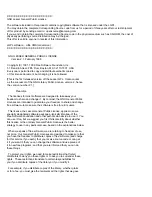
Route Re-Distribution
ExtremeWare XOS 10.1 Concepts Guide
195
Re-Distributing Routes into OSPF
Enable or disable the exporting of BGP, RIP, static, and direct (interface) routes to OSPF using the
following commands:
enable ospf export [bgp | direct | e-bgp | i-bgp | rip | static] [cost <cost> type
[ase-type-1 | ase-type-2] {tag <number>} | <policy-map>]
disable ospf export [bgp | direct | e-bgp | i-bgp | rip | static]
These commands enable or disable the exporting of RIP, static, and direct routes by way of LSA to other
OSPF routers as AS-external type 1 or type 2 routes. The default setting is disabled.
The cost metric is inserted for all BGP, RIP, static, and direct routes injected into OSPF. If the cost metric
is set to 0, the cost is inserted from the route. For example, in the case of BGP export, the cost equals the
MED or the path length. The tag value is used only by special routing applications. Use 0 if you do not
have specific requirements for using a tag. The tag value in this instance has no relationship with
802.1Q VLAN tagging.
The same cost, type, and tag values can be inserted for all the export routes, or policies can be used for
selective insertion. When a policy is associated with the export command, the policy is applied on every
exported route. The exported routes can also be filtered using policies.
Verify the configuration using the command:
show ospf
Re-Distributing Routes into RIP
Enable or disable the exporting of static, direct, BGP-learned, and OSPF-learned routes into the RIP
domain using the following commands:
enable rip export [bgp | direct | e-bgp | i-bgp | ospf | ospf-extern1 | ospf-extern2 |
ospf-inter | ospf-intra | static] [cost <number> {tag <number>} | policy
<policy-name>]
disable rip export [bgp | direct | e-bgp | i-bgp | ospf | ospf-extern1 | ospf-extern2
| ospf-inter | ospf-intra | static]
These commands enable or disable the exporting of static, direct, and OSPF-learned routes into the RIP
domain. You can choose which types of OSPF routes are injected, or you can simply choose
ospf
, which
will inject all learned OSPF routes regardless of type. The default setting is disabled.
OSPF Timers and Authentication
Configuring OSPF timers and authentication on a per-area basis is a shorthand for applying the timers
and authentication to each VLAN in the area at the time of configuration. If you add more VLANs to
the area, you must configure the timers and authentication for the new VLANs explicitly. Use the
command:
configure ospf vlan [<vlan-name> | all] timer <retransmit-interval>
<transit-delay> <hello-interval> <dead-interval> {<wait-timer-interval>}
Summary of Contents for ExtremeWare XOS 10.1
Page 12: ...12 ExtremeWare XOS 10 1 Concepts Guide Contents...
Page 15: ...Part 1 Using ExtremeWare XOS...
Page 16: ......
Page 20: ...20 ExtremeWare XOS 10 1 Concepts Guide ExtremeWare XOS Overview...
Page 32: ...32 ExtremeWare XOS 10 1 Concepts Guide Accessing the Switch...
Page 74: ...74 ExtremeWare XOS 10 1 Concepts Guide Virtual LANs VLANs...
Page 80: ...80 ExtremeWare XOS 10 1 Concepts Guide Forwarding Database FDB...
Page 112: ...112 ExtremeWare XOS 10 1 Concepts Guide Status Monitoring and Statistics...
Page 133: ...Part 2 Using Switching and Routing Protocols...
Page 134: ......
Page 174: ...174 ExtremeWare XOS 10 1 Concepts Guide Virtual Router Redundancy Protocol...
Page 184: ...184 ExtremeWare XOS 10 1 Concepts Guide IP Unicast Routing...
Page 202: ...202 ExtremeWare XOS 10 1 Concepts Guide Interior Gateway Protocols...
Page 216: ...216 ExtremeWare XOS 10 1 Concepts Guide Exterior Gateway Routing Protocols...
Page 224: ...224 ExtremeWare XOS 10 1 Concepts Guide IP Multicast Routing...
Page 225: ...Part 3 Appendixes...
Page 226: ......
Page 234: ...234 ExtremeWare XOS 10 1 Concepts Guide Software Upgrade and Boot Options...
Page 242: ...242 ExtremeWare XOS 10 1 Concepts Guide Troubleshooting...
Page 256: ...4 ExtremeWare XOS 10 1 Concepts Guide Index of Commands...
















































